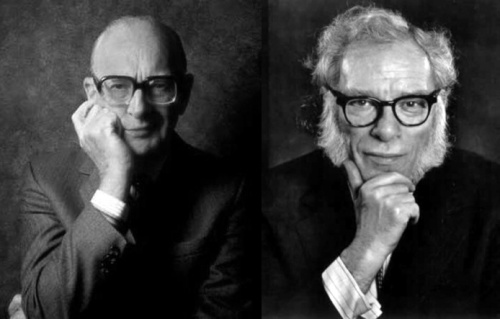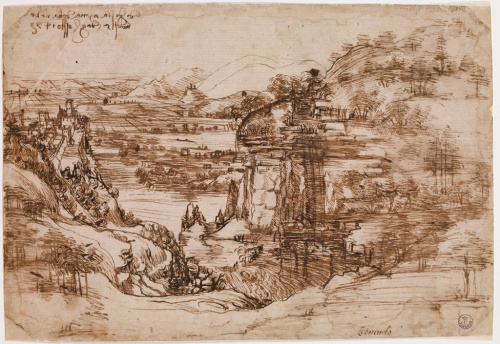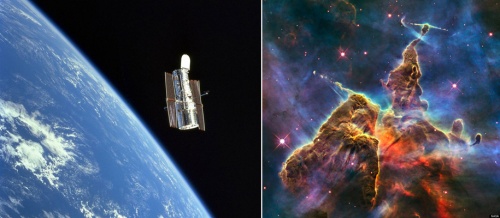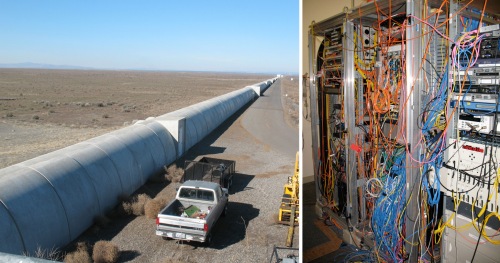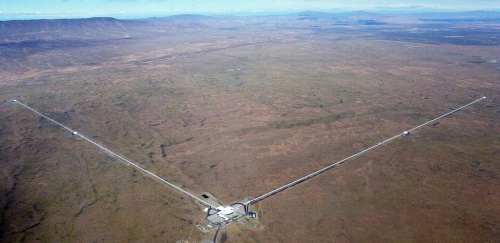by Shane L. Larson
Suppose we wanted to imagine some very big numbers, to somehow develop an appreciation for how BIG the Cosmos truly is. Sitting on a the beach somewhere, one might idly wonder “how many grains of sand are there on all the beaches and in all the deserts of Earth?” Counting is certainly out of the question, so how might you figure that out?
You would do it the same way we “counted” the galaxies in the sky using the Hubble Extreme Deep Field. You count all the grains in some small amount, perhaps a handful of sand picked up off the shores of Lake Michigan. Then you figure out how long and wide all the beaches and deserts are, and how deep the shifting sands run, and figure out how many handfuls of sand would cover them all. Multiplying my the number of grains in my hand, you would find there are some 10 billion billion (1019) grains of sand on the planet Earth. That’s a BIG number; a number that is beyond ordinary human understanding, beyond our everyday experience.
![The night sky over the Pando Forest in central Utah. Pando is an 80,000 year old aspen grove -- it has seen almost 30 million nights like this one, but very little has changed. The constellations change over thousands of years, but the sky is still full of stars, and the Milky Way still arches over the sky, giving the impression that the Universe is unchanging. [Image: Shane L. Larson]](https://writescience.files.wordpress.com/2015/03/pandoforest.jpg?w=253&h=395)
The night sky over the Pando Forest in central Utah. Pando is an 80,000 year old aspen grove — it has seen almost 30 million nights like this one, a sky full of stars [Image: Shane L. Larson]
When there is so much we don’t understand here on our own small planet, it is easy to be overwhelmed by the immense size, the immense possibilities of what we don’t understand in a Universe far larger than our brains can easily imagine. We could very easily crawl into our shells, hide from the immensity, and turn our vision inward, with nary another glance outward into the deep vastness that doesn’t even notice we are here.
But we don’t do that. We have, for countless generations, stared into the immensity in an ongoing (and surprisingly successful) camapign to understand and explain all we can about the Universe. But when everything is so impossibly far away, when the Cosmos is full of so many different and unknown things, how is it that we can know anything? The answer to that question is that we ask questions.
 Consider a popular game that most of us have played since we were kids (I have a 9 year old — I get to play this A LOT). Here is a box (with a question mark on it). You want to figure out what is under this box by asking 20 “Yes-No” questions. Go!
Consider a popular game that most of us have played since we were kids (I have a 9 year old — I get to play this A LOT). Here is a box (with a question mark on it). You want to figure out what is under this box by asking 20 “Yes-No” questions. Go!
- Is it alive? No.
- Is it something made by humans? Yes.
- Is it small enough to hold in my hand? Yes.
- Is it edible? No.
- Does it have batteries? No.
So there we have asked just 5 questions. The answers are nothing more than a simple yes or no. But the tremendous power of asking questions is clear. Despite the vastness of the Cosmos, despite its immense size and the mind-boggling large number of things it contains, you have eliminated almost ALL of it from consideration with only 5 simple questions. You know it is not something huge (galaxy, star, planet, white dwarf, asteroid, comet, …). You know it is not alive, so every organism on Earth — plant, animal, bacteria, fungus, protozoan — is eliminated. Your attention is now focused on only things that humans make, and only those things that aren’t powered by batteries.
 And you have 15 questions left! With 20 carefully constructed questions, you will be able to figure out almost anything I wanted to hide under that question mark, with a high degree of success! If we went on and I let you ask the rest of your 15 questions, I am confident you would eventually arrive at the fact that hiding in my question mark box is a little Lego version of me and Neil deGrasse Tyson.
And you have 15 questions left! With 20 carefully constructed questions, you will be able to figure out almost anything I wanted to hide under that question mark, with a high degree of success! If we went on and I let you ask the rest of your 15 questions, I am confident you would eventually arrive at the fact that hiding in my question mark box is a little Lego version of me and Neil deGrasse Tyson.
We could have done this with anything in the Cosmos. I could have had anything under that box — an elephant, a quasar, a piece of Pluto, the left foreleg of a carpenter ant, a circle of paper from a hole punch, a cough drop wrapper, an oyster shell, that little plastic do-hickey that holds your gas cap on your car, a Calving & Hobbes sketch, a molybdenum atom, Marie Curie’s lab notebook, a lost pawn from a Sorry game, and so on. ANYTHING!
But you can figure out what it is with only a few questions so reliably we’ve made it into a game children can play and enjoy! It’s usually called “20 questions,” but it also goes by the name science. Except when we play science, we don’t limit ourselves to just 20 questions — we ask as many as we want! You can learn a LOT with carefully constructed questions. And we have learned a lot. We have collected and gathered and recorded our knowledge of the Cosmos so effectively that much of it has passed into the communal memory of our species, integrating itself into the fabric of who and what we are so effectively that we often don’t give it a second thought. We’ve forgotten how hard it was to earn that knowledge, the struggle our forbears went through to wrest some secrets from Nature and then understand what they meant.

A 1/2 globe of the Moon, roughly 5 feet in diameter, made before spacecraft had ever flown to the far side. You can see this in the Rainbow Lobby of the Adler Planetarium in Chicago.
To understand this, consider the Moon. What do you know about the Moon? It orbits around the Earth. It is spherical, and is illuminated by the Sun. The near side always faces the Earth. It is covered with lowlands (called maria, lunar “seas”), highlands (called terrae, the brighter areas), mountains, craters, and canyons. All of this is common knowledge, which if you didn’t know it you could have found out using the electronic web that girdles our world. I’m pretty sure almost everyone reading this has not been to the Moon. In all the history of our species, only 24 humans have ever crossed the gulf between the Earth and the Moon; only 12 humans have ever walked on the Moon and seen what we know with their own eyes. The pictures of the Moon, taken by the Apollo astronauts and robotic emissaries have virtually erased from our memory what it was like to not know what the Moon was like.
Consider the globe of the Moon shown here. It is about 5 feet in diameter, and lives up to our expectations of a rugged, desolate landscape covered in mountains and craters. How far away from this globe would I have to stand, for it to look roughly the same as the Moon in the sky? About 140 feet. The full moon in the sky, is about the size of a US dime, held at arm’s length.
![When you see the Moon in the sky, it is quite small, roughly the size of a dime held at arm's length. The detail your eye can see is minimal -- mostly just dark and light shading, with no topography! [Image: Shane L. Larson]](https://writescience.files.wordpress.com/2015/07/moondime.png?w=500&h=374)
When you see the Moon in the sky, it is quite small, roughly the size of a dime held at arm’s length. The detail your eye can see is minimal — mostly just dark and light shading, with no topography! [Image: Shane L. Larson]
In 1609, Galileo Galilei was the first person to plumb the depths of the sky with a telescope, and what he saw shook the foundations of what we thought we knew about the Cosmos. In 1610, he published one of the seminal works in astronomy: Sidereus Nuncius, “The Starry Messenger,” wherein he described all that he had seen during his first excursions in 1609. He wrote of the Moon
“... the Moon certainly does not possess a smooth and
polished surface, but one rough and uneven, and, just
like the face of the Earth itself, is everywhere full
of vast protuberances, deep chasms, and sinuosities.”
Two things stand out to me about this passage. The first is how he initially describes the Moon: a smooth and polished surface. This is how people thought of the Moon — it is, in a very real sense, what the Moon looks like, and what you would think if you had never been taught that there were craters and mountains on its surface. The second is when he describes what he saw on the Moon: just like the face of the Earth itself. The telescope allowed us to see that the Moon had features and topography that were at once recognizable and intimately familiar, appearing just like the topography we see here on Earth. In a singular moment of discovery, the telescope deprovincialized our view of the Earth. The Moon is, in a very real sense, the first world other than the Earth that we ever discovered, and this is how it happened.

Galileo’s planet sketches, while not showing the detail of his lunar observations, were no less revolutionary.
There were many other startling revelations Galileo had looking through the telescope. In addition, he was the first person to look at the planets through a telescope. And what he found was that the planets were not stars at all, but also were other worlds. Every planet showed size, and round shape. The planet Saturn had odd protrusions; Galileo wrote “Saturn has ears.” Turning his telescope to Venus, Galileo found that it went through phases, just like the Moon, a fact that was easily explained by the still new Copernican idea that the Sun was at the center of the solar system. But Jupiter revealed one of the greatest secrets of all — it held in its grasp its own entourage of moons, that orbited the great world much as our own Moon orbits the Earth. Today, they are known as Io, Europa, Ganymede, and Callisto — the Galilean moons.
When I think about these momentous discoveries, my mind always wanders to the following, often overlooked fact: even though Copernicus’ De revolutionibus orbium coelestium had been published more than 60 years before Galileo’s observations, and placed the Earth in orbit around the Sun, Galileo’s observations were the first to reveal the planets were indeed other worlds. To put an even finer point on it, Galileo’s observations were the first to definitively show that the Earth was a planet, possibly not unlike the other planets that orbit the Sun. Galileo’s telescope allowed us to discover the planet Earth.

Galileo’s observations of the Pleiades revealed stars that could not be seen with the naked eye. There was an unseen — an unknown — part of the Cosmos to discover.
Galileo also peered at stars. He found that when he looked at the Pleiades, the Seven Sisters, the telescope revealed stars that could not be seen with the unaided eye. When he peered at the diaphanous glow of the Milky Way, arching horizon to horizon in the dark skies of 17th Century Italy, he found it was comprised of uncountable numbers of individual stars, so far away and so dim that without the telescope their combined light looked no more than an evanescent fog in the dark. The scale of the Universe was suddenly much larger. The structure of the Universe was suddenly more complex. Larger and more complex than humans had ever imagined. The revelation of the Cosmos had begun.
—————————–
This post is the second in a series of three that capture the discussion in a talk I had the great pleasure of giving for Illinois Humanities as part of their Elective Studies series, a program that seeks to mix artists with people far outside their normal community, to stimulate discussion and new ideas for everyone. The first post can be found here: http://wp.me/p19G0g-xB
The idea of describing science in the context of 20 Questions is one I was introduced to at a very young age, by Carl Sagan in “Cosmos: A Personal Voyage” (in Episode 11: Persistence of Memory).



